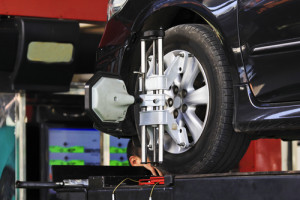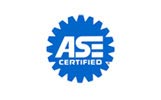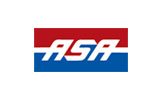How to Tell if Your Car Needs An Alignment

One of the most common types of auto maintenance services is an alignment. There are many reasons for a car’s alignment to become an issue (keep reading to learn more details).
What’s important to understand, however, is that driving a car that is in need of an alignment can become a larger issue if not addressed. An unaligned car leads to uneven tire wear, which can cause tires to lose tread much quicker than they would in an aligned car. Excessive wear on your tires and suspension can be prevented with a simple preventative maintenance plan. For the good of your car and your wallet, taking the preventative measure of having your vehicle aligned can save hundreds of dollars and prolong the life of your tires.
How to Tell if Your Car Needs an Alignment
In order to drive optimally, the steering and suspension systems in your car must be calibrated perfectly. This keeps the tires in good alignment and ensures smooth driving. Minor shifts in the way these systems are calibrated can result in a wheel misalignment that negatively impacts your driving. When this happens, it’s time to get an alignment done.
A misalignment can be very subtle, so you might not notice it while driving. Fortunately, there are a few signs you can look for when determining whether your car needs an alignment. We’ll go over these in detail, but first, let’s look at what exactly causes your car to get unaligned.
Causes of Misalignment

Everyday driving, traffic, uneven roads, and the normal stresses that driving puts on your vehicle will naturally wear on your car’s tires and alignment. As a result, even the world’s best drivers still face alignment issues. Sometimes, this can happen faster than usual as your car encounters uneven roads, potholes, curbs, etc.
Other factors that speed up misalignment issues include uneven weighting on your vehicle (such as if you have a constant heavy load in the trunk), reckless driving, and poor balance of tire air pressure. Over time, these can all put stress on the suspension and steering systems in your vehicle, leading to a shift in wheel alignment.
The issue isn’t with the tires, but rather with the suspension of the car that causes tires to tilt or bow in or out. Normal driving can cause parts of the suspension to rotate, tweak, or bend. Alignment is measured by the angles of your tires from the side and from the top of the car. Once you’ve had your car aligned, you will likely be able to tell a big difference in the ease of driving and the car’s overall performance.
Signs to Look For
Every 5,000 to 6,000 miles, your car should be taken in for an alignment just to keep everything finely tuned. There isn’t a warning light or any kind of alignment notification from your car, but most manufacturers recommend getting your car aligned every 6,000 miles or so. Before going through with the entire alignment, have a mechanic check your suspension to see if it is need of an alignment.
In addition, the following signs can indicate that your vehicle’s wheels are misaligned:
- Vehicle pulling to the side. If you notice that your car naturally tends to veer or pull slightly in one direction, even when you are carefully trying to drive perfectly straight; it’s probably time for an alignment. A properly aligned car will drive straight when the steering wheel is straight, but an unaligned car might drift to the side with a straight steering wheel or require lots of correction.
- Uneven tire wear. One of the easiest ways to tell if your car is unaligned is to check the tire tread. Ideally, tires will wear evenly on all sides. A car in need of an alignment will have fairly obvious wear that is uneven between the edges of the tire. If you notice feathering or uneven wear on your tires, it may be time to schedule your vehicle alignment.
- Vibrating steering wheel. If your steering wheel is working hard to keep your car moving straight when the wheel isn’t centered, it is common for the steering wheel to vibrate or hum. If this is an issue with your car, it may not be aligned.
- Squealing tires. If your tires squeal semi-regularly, it could mean your car’s alignment should be checked.
- Crooked steering wheel. If your steering wheel is slightly crooked when you’re heading straight, this could indicate it’s time to see the mechanic.
When you take your vehicle in for an alignment, the mechanic will perform additional tests to find signs of these problems. The tests are designed to gauge the tires for slanting in any direction, including:
- Camber angle, or the slant of the tire on an up-and-down angle as viewed from the front.
- Toe alignment, or the way tires might point inward or outward when viewed from above.
- Caster angle, or any forward or backward slant of the steering axis when viewed from the side.
These angles are difficult to see without the proper equipment, but they have a major effect on the way your car handles.

After Your Alignment
Once everything has been fixed with regards to your car’s alignment, your car will be able to drive optimally once again. Some of the specific benefits you’ll see include:
- Easier handling.
- Less resistance between your tires and the road, leading to less tire wear and longer tire life.
- Improved gas mileage due to reduced tire resistance.
- No more vibration or veering issues.
No car is completely immune to wheel misalignment, but it is fairly inexpensive to fix, especially when compared to the price of new tires. Careful driving, reducing the load in your car, maintaining proper tire air pressure, and getting an alignment every 6,000 miles can all keep your car driving smoothly for much longer. In the meantime, if you notice any of the above signs, take your car in for an alignment as soon as possible.
A vehicle alignment is an easy way to prolong the life of your tires, make your car more enjoyable to drive, and help balance things out on rough roads. It doesn’t take much effort or maintenance to make a big difference.
Call Autotailor, your Greeley auto repair specialists to schedule an appointment today.



